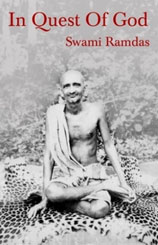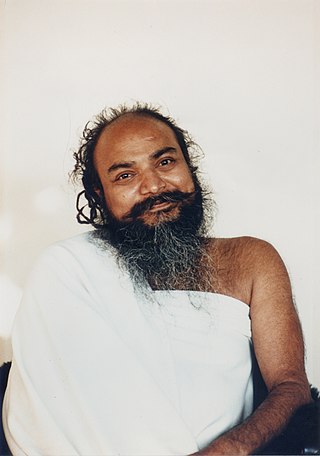
Sri Yukteswar Giri is the monastic name of Priya Nath Karar, an Indian monk and yogi, and the guru of Paramahansa Yogananda and Swami Satyananda Giri. Born in Serampore, West Bengal, Sri Yukteswar was a Kriya yogi, a Jyotisha, a scholar of the Bhagavad Gita and the Upanishads, an educator, author, and astronomer. He was a disciple of Lahiri Mahasaya of Varanasi and a member of the Giri branch of the Swami order. As a guru, he had two ashrams, one in Serampore and another in Puri, Odisha, between which he alternated his residence throughout the year as he trained disciples.
M. P. Pandit was a spiritual author, teacher and Sanskrit scholar. For several decades, he was a secretary of the Mother of the Sri Aurobindo Ashram. He wrote numerous books and articles on the yoga of Sri Aurobindo and the Mother, on social and political thought, science, philosophy, religion, mysticism, and the classical texts and spiritual traditions of India.

Siddharudha Swami is an Indian Hindu Guru: and Philosopher.

Gopinath Kaviraj was an Indian Sanskrit scholar, Indologist and philosopher. First appointed in 1914 a librarian, he was the Principal of Government Sanskrit College, Varanasi from 1923 to 1937. He was also the editor of the Sarasvati Bhavana Granthamala during that period.

Swami Ramdas was an Indian saint, philosopher, philanthropist and pilgrim. Swami Ramdas became a wandering ascetic in his late 30s and after attaining moksha while still alive established Anandashram in Kanhangad, Kerala. He is the author of several books, the most famous of which is the spiritual autobiography In Quest of God (1925).
The Shri Guru Charitra is a book based on the life of Shri Nrusimha Saraswati, written by the 15th-16th century poet Shri Saraswati Gangadhar.
Jagadguru Shankaracharya Swami Bharatikrishna Tirtha (1884–1960), born Venkataraman Shastri, was an Indian Hindu monk and Shankaracharya of Govardhana Math in Puri in the Indian state of Odisha, from 1925 through 1960. He is particularly known for his book Vedic Mathematics , being the first Sankaracarya in history to visit the West, and for his connection with nationalist aspirations, thus earning him the title 'Father Of The Vedic Maths'.

Kavisekhara Dr. Umar Alisha, was the sixth Peethadhipathi of Sri Viswa Viznana Vidya Adhyatmika Peetham in Pithapuram, India. He succeeded his father Mohiddin Badusha I.
Hussain Sha was the seventh head of Sri Viswa Viznana Vidya Adhyatmika Peetham in Pithapuram. He was born in Rajahmundry, East Godavari District. He succeeded his father, Kavisekhara Dr Umar Alisha Sathguru. He completed his primary education at Pithapuram and passed the Final Arts course from National College in Machilipatnam. He was a scholar in Telugu, Arabic, Urdu, Persian and Sanskrit.
Sri Mohiddin Badsha II, was a scholar in Telugu, Arabic, Urdu, Sanskrit, Parsee and English. Son of Sri Brahmarishi Hussain Sha and Ajeemunnisa Begum. He married Fatima Jaharunnisa Begum on May 19, 1963. He had six sons and three daughters. He took over the Lordship of Peetham as 8th Head on September 25, 1981. Due to the old age and ill health of his father Brahmarishi Hussain Sha Sathguru and as a future Head of the Institution, he had undertaken the preceptive of the Peetham's philosophy from 1969.He delivered speeches at many villages of Andhra Pradesh to promote Jnana yoga.

Mirtola is a village 10 km away from Almora, in Uttarakhand state in India. It is best known for an ashram by the same name, also called Uttar Brindaban, set up by Sri Yashoda Ma, a housewife turned ascetic in the 1930, along with her disciple Sri Krishna Prem (1898–1965), a mystic of the 20th Century. The ashram was later run by his disciple, Sri Madhava Ashish (1920–1997), another Briton, who also later settled in India.

Shri Shivabalayogi Maharaj was a yogi who claimed to have attained self-realization through twelve years of arduous tapas, meditating in samādhi for an average of twenty hours a day.

Chidananda Saraswati was president of the Divine Life Society, Rishikesh, India. He is well known in India as a yogi and spiritual leader. He succeeded as president of the Divine Life Society in 1963, after the death of his predecessor, Sivananda Saraswati, who founded the Society.

Swami Nigamananda Paramahansa was an Indian yogi, guru and mystic well known in Eastern India. He is associated with the Shakta tradition and viewed as a perfect spiritual master of vedanta, tantra, yoga and prema or bhakti. His followers idealized him as their worshipped and beloved thakura.

The Advaita Guru-Paramparā is the traditional lineage (parampara) of divine, Vedic and historical teachers of Advaita Vedanta. It begins with the Daiva-paramparā, the gods; followed by the Ṛṣi-paramparā, the Vedic seers; and then the Mānava-paramparā, with the historical teachers Gaudapada and Shankara, and four of Shankara's pupils. Of the five contemporary acharyas, the heads of the five Advaita mathas, four acharyas trace their lineage to those four pupils and one to Adi Shankara himself.
Malayala Swamy (1885–1962) was a Hindu religious leader, and a social reformer. He dismissed the myth that Vedas and other scriptures are only for a particular section of the society and encouraged common man to gain spiritual knowledge. He also encouraged women education. He was the founder of Sri Vyasashrama in Yerpedu, Andhra Pradesh. He influenced Swami Vidya Prakashananda Giri, his famous disciple who established Sri Sukabrahmashrama at Srikalahasti.

Swami Vidya Prakashananda Giri, born Ananda Mohan, was an Indian spiritual Guru from Andhra Pradesh. He was a disciple of Malayala Swamy. He was the founder of Sri Sukabrahmashram in Srikalahasti. His commentary on Bhagavad Gita named Geetha Makarandam is one of the prominent works in spiritual literature.

Tummalapalli Ramalingeswara Rao was a Telugu poet, novelist, literary critic, philosophical journalist, writer of English prose and an exponent of Mantra Shastra and tradition. His works covered a wide range of subjects like history, sociology, literature, philosophy, religion and spiritualism. His popular works include Sri Lalitha Sahasranama Stotra Bhashyamu, Sri Chakra Vilasanamu, Sri Chakra Pooja Vidhanam, Dharmanirnayam, Tikkana Somayaji, Sivanugrahamu Pitruyagnamu (Poetry) and Sringeri Revisited.
The Parashurama Kalpasutra is a Shakta Agama, a Hindu text on Shri Vidya practices ascribed to the Kaula tradition. The authorship of the text is traditionally attributed to Parashurama, the sixth avatar of Vishnu and a disciple of Dattatreya. It is a sacred text for the Shri Vidya worshippers of the goddess Lalita, who is considered to be a manifestation of the goddess Adi Parashakti. The text is also used in the worship of Ganesha, Bala Tripurasundari, Matangi, and Varahi. This text has its origins in the Dattatreya Samhita and was compiled by Sumedha, a disciple of Dattatreya.











